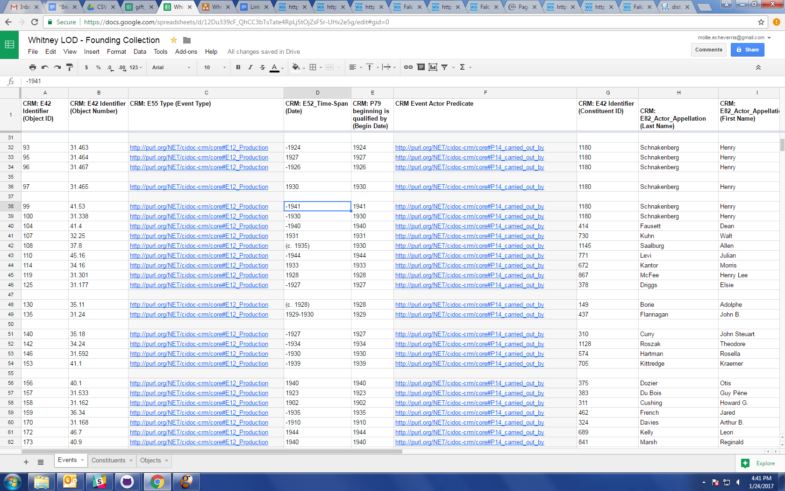Meeting With Everyone
I’m still waiting on a response from Matt regarding a meeting with everyone to discuss the Fellowship. I will ask him about it at the next Linked Jazz meeting on Thursday.
Tabular Data Cleaning
I made some good progress on Friday in working on a master spreadsheet with all Object and Acquisition-related constituents for the Founding Collection.
One issue I noticed in looking at Joshua’s data were three suites of prints in the founding collection (31.694.1-10, 33.83.1-6, 34.37.1-6). The three suites only had one Object ID per suite, despite the fact that they are separate objects with separate creators.
Additionally, there were a smattering of artists with work in the Founding Collection who were not listed in Joshua’s Artist Data spreadsheet, and who did not have Whitney IDs created for them.
Namespace/URI Considerations
I’ve started by trying to map Joshua’s Object-related constituents unto a CIDOC event structure.
CIDOC’s official URIs lead to dead links, despite an apparent plan by the Internal Council of Museums to implement redirects .
CIDOC does have the schema available as an RDFs file. I need to do more research on RDF files as a persistent namespace, but that could be an option.
“ A source of honest confusion, however, is that RDF can be expressed as XML. Lassila’s note regarding the Resource Description Framework specification from the World Wide Web Consortium (W3C) states, “RDF encourages the view of ‘metadata being data’ by using XML (eXtensible Markup Language) as its encoding syntax.”4 So even though RDF can use XML to express resources that relate to each other via properties, identified with single reference points (URIs), RDF is itself not an XML schema. RDF has an XML language (sometimes called, confusingly, RDF, and from here forward called RDF/XML). Additionally, RDF Schema (RDFS) declares a schema or vocabulary as an extension of RDF/XML to express application-specific classes and properties.5 Simply speaking, RDF defines entities and their relationships using statements. There are various ways to make these statements, but the original way formulated by the W3C is using an XML language (RDF/XML) that can be extended by an additional XML schema (RDFS) to better define those relationships. Ideally, all parts of that relationship (the subject, predicate, object, or the resource, property, property value) are URIs pointing to an authority for that resource, that property, or that property value.”
Hardesty, J. j. (2016). Transitioning from XML to RDF: Considerations for an Effective Move Towards Linked Data and the Semantic Web. Information Technology & Libraries, 35(1), 51-64. http://search.ebscohost.com.ezproxy.pratt.edu:2048/login.aspx?direct=true&db=llf&AN=114479090&site=ehost-live
For now, I’m following suite with the British Museum and using the Erlangen mapping of CIDOC to OWL for CIDOC class namespaces.
Erlangen’s URIs, however, just initiate a download of a namespace file with the whole schema, rather than leading to URIs for individual classes and properties.
Another solution I’ve considered is using Dublin Core terms to fill in for CIDOC classes/properties, as Dublin Core does provide persistent URIs for terms in its ontology.
There’s also this OWL ontology for provenance:
https://www.w3.org/TR/prov-o/#description
http://openorg.ecs.soton.ac.uk/wiki/Linked_Data_Basics_for_Techies
Another XML mapping:
http://ws.nju.edu.cn/falcons/ontologysearch/details/recommendation.jsp?id=13022081
